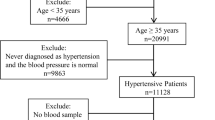Abstract
The balance of evidence from observational studies suggests that elevated homocysteine levels are associated with increased risk of carotid artery disease and stroke. There is however a paucity of prospective studies. There are also concerns regarding confounding due to factors associated with hyperhomocysteinemia, including renal impairment, an atherogenic diet and cigarette smoking. Homozygosity for a defective thermolabile variant of MTHFR, a common genetic polymorphism which results in hyperhomocysteinemia, has not been consistently linked with stroke or other vascular disease. There is a need for additional prospective studies with data on relevant confounders, sufficient power to characterise the form of the association between homocysteine concentrations and stroke risk, whether linear or threshold, and power to study interactions between homocysteine, other dietary markers and established stroke risk factors such as smoking and hypertension. Similarly, the evidence linking hyper- homocysteinemia with hypertension is limited and inconsistent. Given the biological mechanisms proposed in support of the homocysteine-CVD hypothesis, one would predict a positive association between homocysteine and blood pressure. There is a need to address this hypothesis directly in studies with reliable measurements of both homocysteine and blood pressure. Ultimately, the case for a causal role for elevated homocysteine levels in vascular disease, including hypertension and stroke, will depend on data from randomised controlled trials of homocysteine lowering interventions. Given the high prevalence of hyperhomocysteinemia in apparently well nourished populations and the tendency for homocysteine concentrations to increase with age, modest effects of homocysteine on stroke risk will have profound implications for public health
This is a preview of subscription content, access via your institution
Access options
Subscribe to this journal
Receive 12 digital issues and online access to articles
$119.00 per year
only $9.92 per issue
Buy this article
- Purchase on Springer Link
- Instant access to full article PDF
Prices may be subject to local taxes which are calculated during checkout
Similar content being viewed by others
Author information
Authors and Affiliations
Rights and permissions
About this article
Cite this article
Perry, I. Homocysteine, hypertension and stroke. J Hum Hypertens 13, 289–293 (1999). https://doi.org/10.1038/sj.jhh.1000803
Received:
Revised:
Accepted:
Published:
Issue Date:
DOI: https://doi.org/10.1038/sj.jhh.1000803
Keywords
This article is cited by
-
A meta-analysis of association between C677T polymorphism in the methylenetetrahydrofolate reductase gene and hypertension
European Journal of Human Genetics (2007)
-
Plasma homocysteine concentration and blood pressure in healthy Iranian adults: the Tehran Homocysteine Survey (2003–2004)
Journal of Human Hypertension (2005)
-
Hyperhomocysteinemia but not MTHFR genotype is associated with young-onset essential hypertension
Journal of Human Hypertension (2003)
-
Atherosklerose und Urämie: Die Bedeutung nicht-traditioneller Risikofaktoren
Wiener Klinische Wochenschrift (2003)


